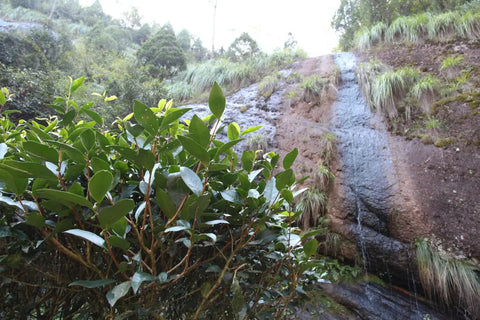
The Wonderful World of Wuyi Oolong Rock Teas
In the northern part of Fujian Province in China lies the Wuyi Mountain Range (known as Wuyishan), which hosts a beloved national park. The area was recognized by UNESCO as a world heritage site in 1999, and for plenty of good reasons.

Between the astonishing scenic views and rich biodiversity, there is truly so much to love. Some of the towering mountain peaks rise well up over 1,000m above sea level, and the highest, Mount Huangang, tops off at 2,158m. So much of the area is adorned with beautiful, running mountain waters and dazzling, majestic cliffs. It is considered one of the most attractive regions in southeast China.
The area itself is a carefully crafted masterpiece, a testament to the humbling forces of nature. It was originally formed from intense volcanic activity before being subject to thousands of years of erosion and weathering from the nearby humid sea air and rainfall, leaving behind impressive, winding valleys and spidering cave systems. It is its volcanic origins that also imparted to it unique, minerally dense soil.
Fortunately for us, Wuyishan also happens to be the home to Wuyi Oolong teas!

Wuyi teas are some of the earliest produced oolongs on record, dating back more than 400 years. The unique environment of Wuyi Mountain—the rough, rugged terrain and steep slopes—is solely responsible for what gives these oolongs their very distinctive, familiar characters, especially the rich, dark, baked fruit notes we have come to know and love. The almost prehistoric environment of Wuyishan, where this tea grows, is the reason you might also sometimes hear it referred to as yan cha or “rock tea.”
Although they are amazing, it is also true that Wuyi oolongs can sometimes be a little expensive. Why?
The simple answer is that production yields for good Wuyi oolongs tend to be on the lower side, and with less high-quality tea to go around and more people interested in it, it’s a recipe for competition to get hands on the good tea.
Tea is harvested when the weather is more on the ideal side, in large part because the leaves will absorb the moisture and affect production, but in the Wuyi mountain range, a place with high humidity and frequent rainfall, it is not always easy to find the opportunity for picking leaves. Because important parts of the production process involve withering and baking, more moisture means more opportunity for things to go wrong.

When it is ready, a good Wuyi oolong must have the right level of oxidation, neither too green nor too brown, usually upon close inspection showcasing colors of deep emerald, ruby red, gold, citrine, caramel, and baked cinnamon. If it retains too much moisture, the initial infusion can appear cloudy, taste weak, or even seem bitter; but if it is baked too long, you end up with a tea that tastes burnt like carbon or ash. Neither extreme is good, and yet one or the other is sadly all too common with cheaper quality Wuyi teas.
A good Wuyi oolong, by contrast, is valued above all for its complexity, owing to its volcanic heritage and meticulous preparation. Like a fine red wine (such as an old vine Zinfandel), it is a tea that should be bright and fruity, yet tempered by a bold minerality, as if it were somehow equal parts yin and yang. It is precisely its complexity that helps it pair all too well with most meals, from savory breakfasts to heartier dinners, making it an extraordinarily versatile tea that is able to be enjoyed in most settings.
